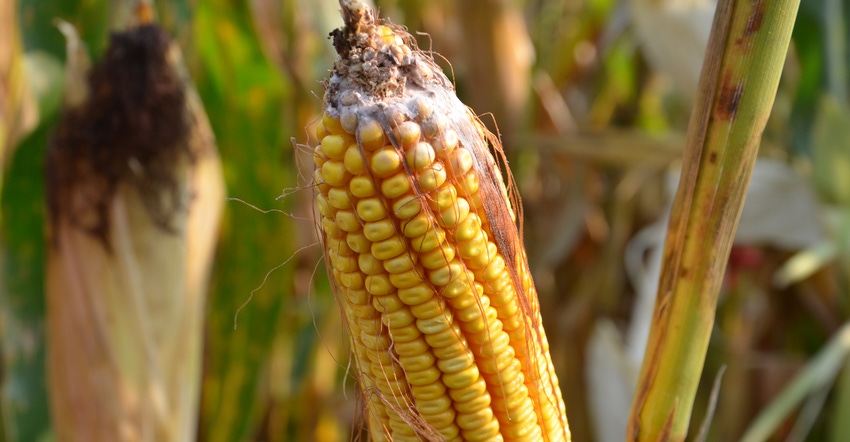July 29, 2019

It’s been a stressful season, starting with very late corn planting and too much rain in June when corn was small. Is this going to mean more ear diseases and stalk rot this fall? If so, which ones should I suspect? What actions can I take?
The Indiana certified crop advisers panel answering this question includes Betsy Bower, Ceres Solutions, Terre Haute; Traci Bultemeier, Corteva/Pioneer, Fort Wayne; and Dan Ritter, Dairyland Seed, Wabash.
Bower: When we think of wet years, we think about more disease overall, but that may not be the case this year. For disease, we need the host crop that can be infected, the disease and the correct environment — which includes air temperature, hours of leaf wetness and relative humidity.
Conditions conducive to ear rots include wet, humid conditions at silking and up to three weeks post-silking. Regarding ear rots, we need to note conditions of each field at silking and a few weeks after. We need to know the environment the corn experienced during normal infection timing.
Regarding stalk disease, we won’t know until later, when we can understand stresses we got during pollination and grain fill. More nitrogen loss in some fields or some soil types this year could provide a stress during grain fill that could lead to stalk rot. Infection can take place through roots, crown tissue or stalks. What’s common for stalk rots is good growing conditions early followed by stress.
In July we found several leaf diseases, including grey leaf spot and physoderma brown spot, that can develop into stalk rot depending on the hybrid. We also saw diplodia leaf streak, which is a different fungus than diplodia ear rot, as well as common and southern rust and one known tar spot infection.
Fungicides applied after tassel mainly just control leaf diseases. To improve your chances with ear and stalk rot management, scout fields starting around mid- to late kernel fill. If you find ear rots or stalk rots, better manage when you harvest. Depending on the ear rot, you may want to harvest early and dry grain to certain moisture levels to limit development of mycotoxins. For stalk rots you may need to harvest early to limit lodging. Scout, scout, scout.
Bultemeier: With any disease, all three parts of the disease triangle must come together: pathogen, host and environment. How much these three components overlap lends to the severity of the disease.
Weather conditions at pollination will dictate much of the severe ear mold appearance like gibberella, diplodia and fusarium. These pathogens move into the ear via silks with moisture present. Each disease is also temperature-dependent. Since pollination will occur from mid-July through sometime in early to mid-August around Indiana, we’ll see different results in different areas.
Knowing when your fields will pollinate along with the hybrid susceptibility in each field will help you prioritize which fields to be concerned about. There’s no significant data that shows any product being great at controlling ear molds. Planting date and residue management are good ways to reduce risk. However, the 2019 planting season may not have left growers many options for those practices.
Stalk rots are brought on by stress to plants any time of the season. Corn in Indiana has certainly been stressed. Fusarium rots, gibberella and diplodia stalk rot, along with other secondary diseases that come along for the ride, reduce standability and nutrient and water movement within the plant. These can occur early after pollination or later — again, it’s environment-dependent. Fusarium crown rot appears to set in during early, wet conditions and can be a significant yield robber because of its rapid and early cutoff of nutrient movement in the plant.
Field scouting and prioritization of field harvest is the best way to reduce yield losses when stalk rots occur.
Ritter: Early-season stresses had a small part to play in ear and stalk disease issues. Typically, ear diseases are initiated during the flowering period, so weather during that period will have a greater influence on ear disease than during the vegetative periods.
As far as stalk rots are concerned, infection occurs at various times depending on the disease, but mostly again at or after silking. The best action would be to review the weather condition and crop stages, especially through the reproductive stages of your corn crop. This may help you identify which diseases to expect. Monitor fields closely through grain fill and early maturation.
If stalks are getting weak or grain starts to show signs of disease, get it harvested, dried and in a bin or marketed. Last fall we all found out drying costs are cheaper than some headaches we dealt with during harvest.
You May Also Like




